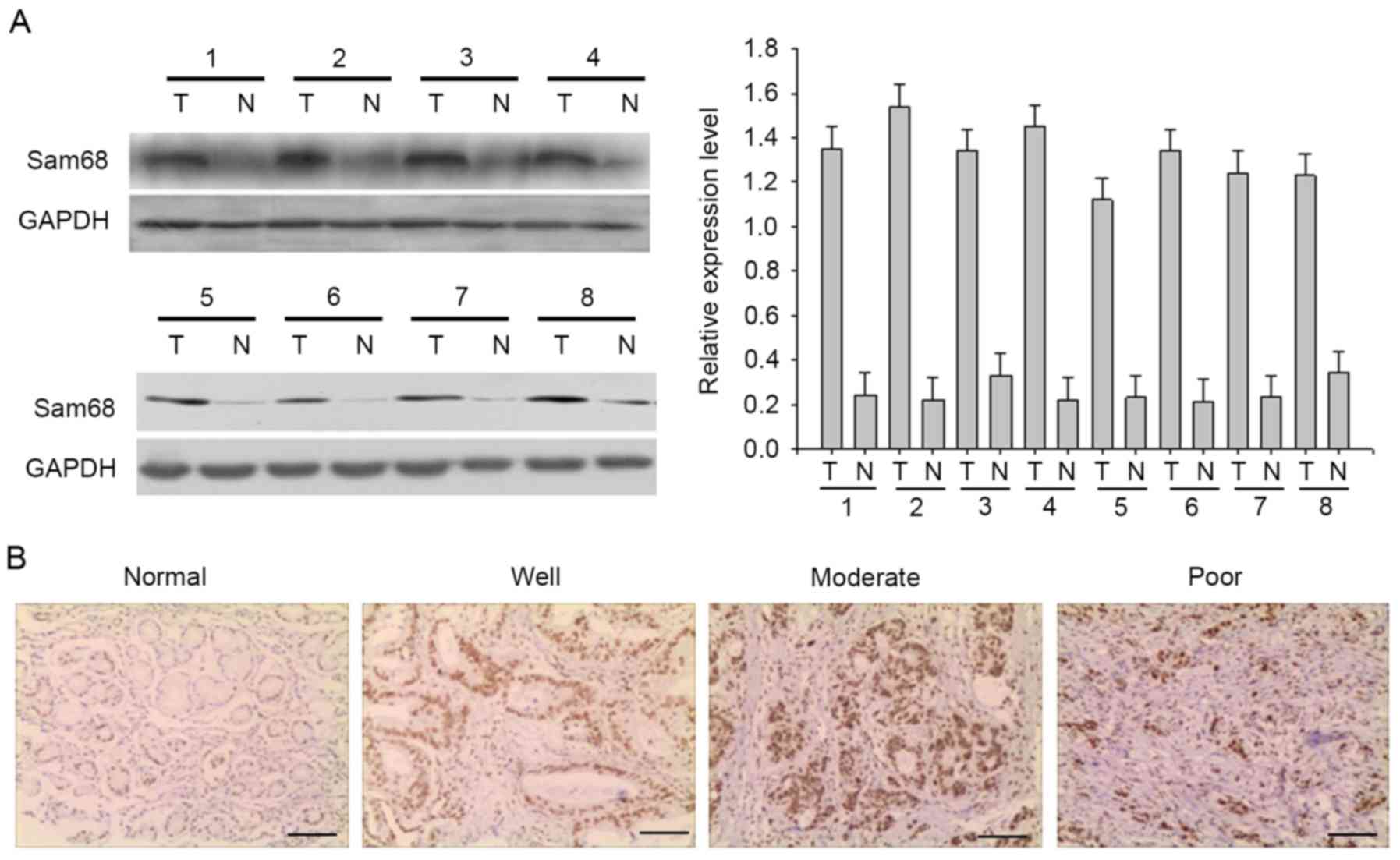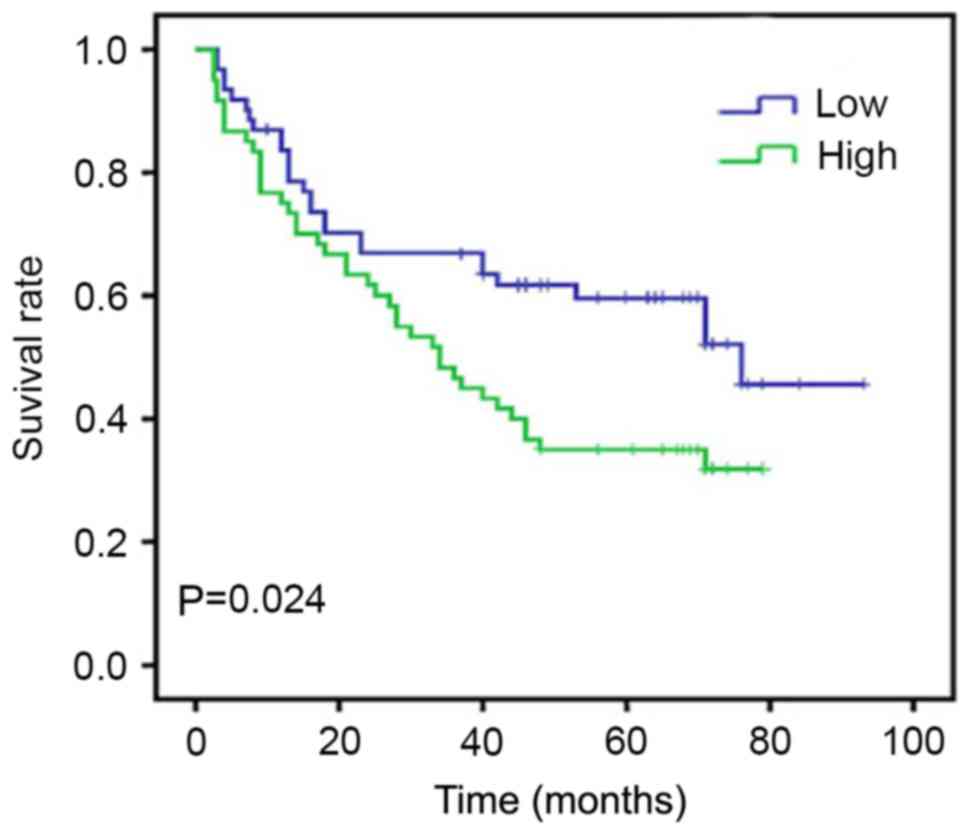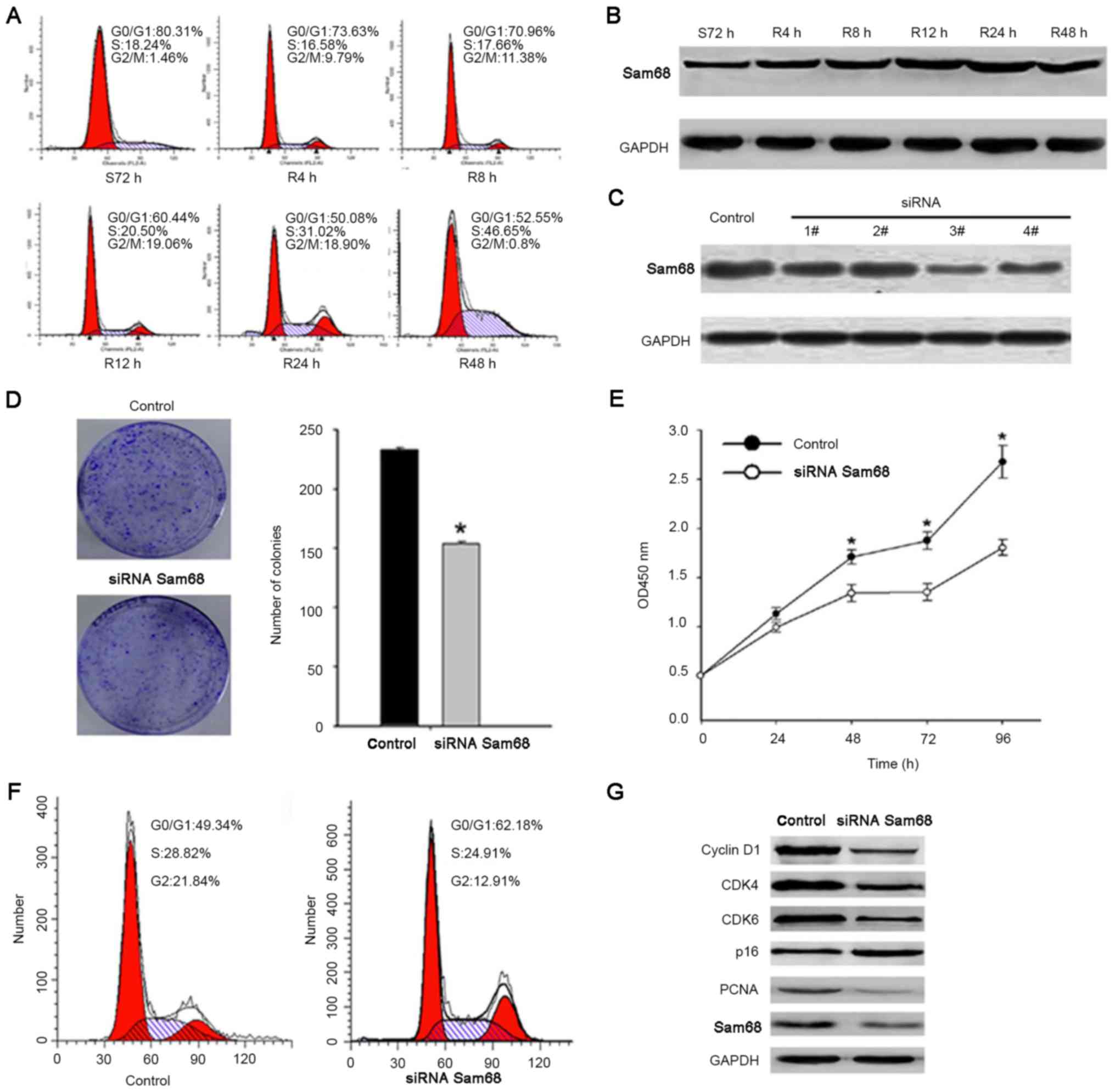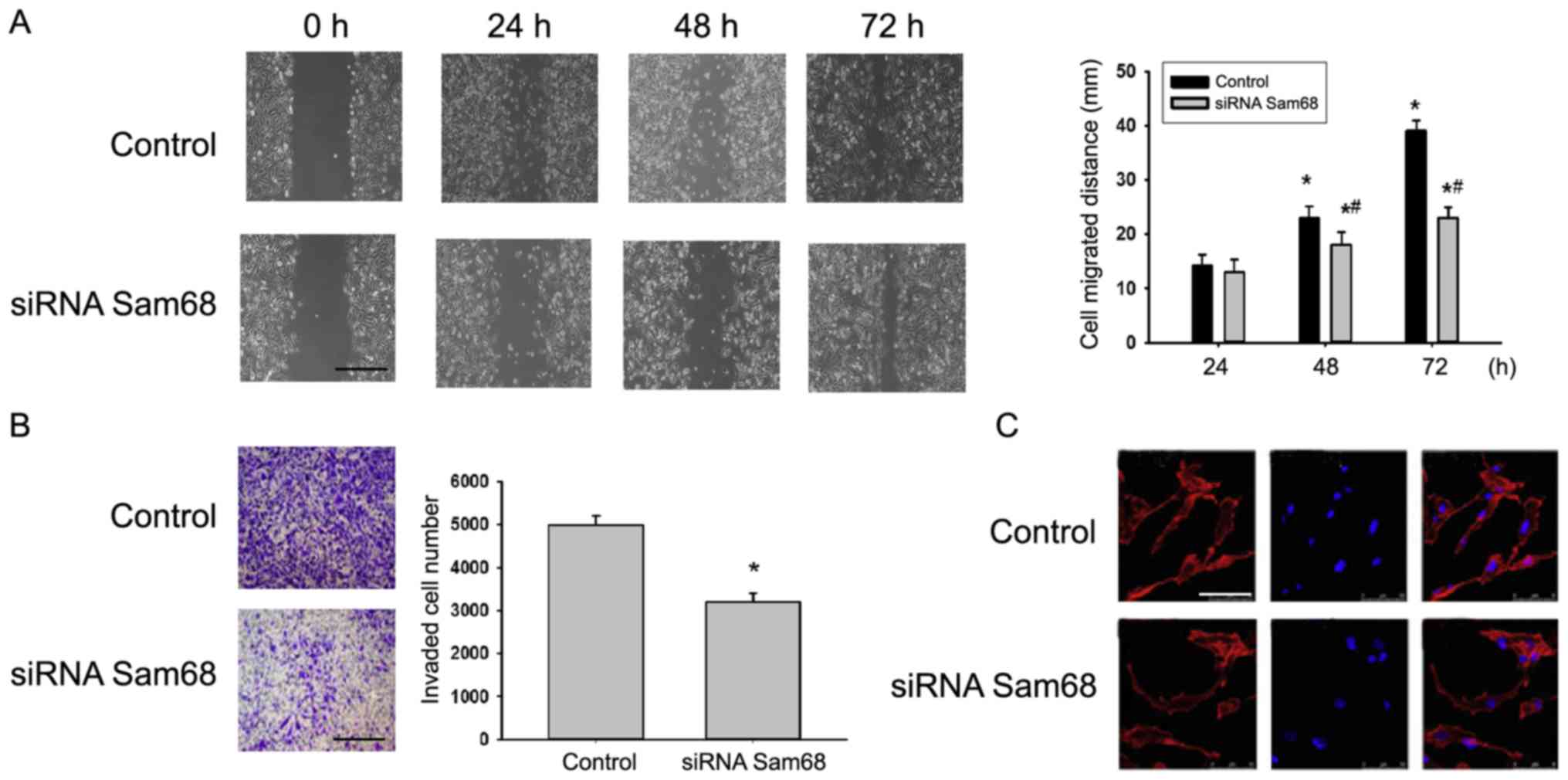Clinical significance and effect of Sam68 expression in gastric cancer
- Authors:
- Published online on: February 2, 2018 https://doi.org/10.3892/ol.2018.7930
- Pages: 4745-4752
-
Copyright: © Xiao et al. This is an open access article distributed under the terms of Creative Commons Attribution License.
Abstract
Introduction
Gastric cancer is one of the most common types of malignant tumors worldwide, and is possibly the main cause of cancer-associated mortality (1). The incidence of gastric cancer varies across populations, with almost two-thirds of gastric cancer cases and mortalities occurring in less developed regions (2). Despite a decline in the incidence of gastric cancer in the West, it remains one of the most frequent types of cancer diagnosed in China. There has been no significant change in the number of cases of gastric cancer-associated mortality, and the treatment methods remain challenging (3). Although a previous study has indicated that several mechanisms are involved in the development of gastric cancer, its pathogenesis remains unclear (4).
Src-associated in mitosis of 68 kDa (Sam68), which was originally identified as a substrate for Src kinase, is a member of the signal transduction and activation of splicing RNA family of K homology (KH) domain-containing RNA-binding proteins (5,6). Sam68 is ubiquitously expressed in numerous tissues and cell lines, and it performs important roles in gene transcription, signaling transduction and alternative splicing via the phosphorylation modification (7). Sam68 has deregulated expression, and it is involved in the promotion of cell cycle progression, cell proliferation, transformation, tumorigenesis and metastasis in numerous types of cancer (8). However, at present, it is uncertain whether Sam68 has clinical significance in gastric cancer. Therefore, the present study investigated the expression of Sam68 in gastric cancer samples to identify its potential prognostic role.
Materials and methods
Patients and tissue samples
In this retrospective study, a total of 161 surgically-resected gastric cancer tissue specimens (53 male and 108 female; 24–72 year of age), obtained from patients who were enrolled according to the 7th edition of the International System of Staging for Gastric Cancer (4), were collected at the Affiliated Nantong Cancer Hospital of Nantong University (Nantong, China) between February 2004 and February 2007. Patient baseline demographics, clinicopathological characteristics and surgical approach information was collected following a review of the clinical notes and histopathology reports. Outcome data, including long-term survival, were recorded. None of the patients received radiotherapy or chemotherapy prior to tumor resection. Patients with disease recurrence or metastasis were treated with platinum-based systemic chemotherapy. The present study was approved by the Ethics Committee of the Affiliated Nantong Cancer Hospital of Nantong University, and written informed consent was obtained from all patients.
Western blot analysis
Frozen gastric cancer samples were homogenized in radioimmunoprecipitation assay buffer (25 mM Tris, 150 mM NaCl, 0.1% SDS, 0.5% sodium deoxycholate and 1% Triton X-100). Following centrifugation at 12,000 × g for 20 min at 4°C, 60 µg total protein from each sample was resolved with 10% SDS-PAGE and transferred to a polyvinylidene fluoride membrane (EMD Millipore, Billerica, MA, USA). Subsequent to blocking with 5% non-fat milk at room temperature for 60 min, the membranes were incubated with rabbit monoclonal antibodies against Sam68 (dilution, 1:1,000; cat. no. sc-4249; Santa Cruz Biotechnology, Inc., Dallas, TX, USA) and GAPDH (dilution, 1:1,000; cat. no. sc-47724; Santa Cruz Biotechnology, Inc.) at 4°C overnight. Membranes were then washed with TBS-Tween-20 (TBST) and incubated with a horseradish peroxidase (HRP)-conjugated anti-rabbit secondary antibody (dilution, 1:10,000; cat. no. sc-2030; Santa Cruz Biotechnology, Inc.) for 60 min at room temperature. After washing with TBST, the membrane was developed using an enhanced chemiluminescence system (EMD Millipore). The intensities of the protein bands were determined by densitometry using ImageJ software (version 2.1; National Institutes of Health, Bethesda, MD, USA).
Immunohistochemistry
The gastric cancer tissues were fixed with 10% formalin for 24 h at room temperature and then embedded with paraffin at 60°C for 5 min. The 8-µm thick slides were immersed in EDTA (pH 8.0) and incubated for 20 min in a microwave oven for antigen retrieval. Subsequent to rinsing with PBS, endogenous peroxidase was blocked with 0.3% hydrogen peroxide in PBS at room temperature for 15 min. The slides were incubated with anti-Sam68 antibody (dilution, 1:50; cat. no. sc-4249; Santa Cruz Biotechnology, Inc.) in a humidified chamber at 4°C overnight. Following additional washing with PBS three times, the sections were sequentially incubated with HRP-conjugated secondary antibody (dilution, 1:100; cat. no. sc-6772; Santa Cruz Biotechnology, Inc.) at 37°C for 30 min and then washed three times with PBS. Finally, diaminobenzidine tetrahydrochloride was used for the signal development. Subsequently, 10% hematoxylin staining buffer (cat. no. H9627; Sigma-Aldrich; Merck KGaA) was added to stain the nucleus at room temperature for 30 sec. PBS was used as a negative control. Immunoreactivity was detected using light microscopy (DM2000, Leica Microsystems GmbH, Wetzlar, Germany), and evaluated independently by two experienced gynecopathologists blinded to the clinical data. The detection of Sam68 expression was performed as previously reported (9). To analyze the staining of Sam68 in these tissue, the 100 hematoxylin-positive cells in which Sam68 was also positive were identified. The staining proportion was scored as follows: 0, no positive cells; 1, <10% positive cells; 2, 10–35% positive cells; 3, 35–70% positive cells; 4, >70% positive cells. Staining intensity was graded according to the method of mean optical density: 0, no staining; 1, weak staining (light yellow); 2, moderate staining (yellow brown); 3, strong staining (brown). The immunoreactivity score (IRS) was calculated as the product of the staining intensity score and the percentage of positive cells that ranged between 0 and 12. Optimized cutoff points for each categorical score were determined using log-rank statistics. This scoring was based on the assumption that a staining index score ≥6 indicated high Sam68 expression, whereas a staining index score ≤6 indicated low Sam68 expression as previous reported (10).
Cell culture and small interfering RNA (siRNA) transfection
AGS cells were obtained from the American Type Culture Collection (Manassas, VA, USA) and cultured in Dulbecco's modified Eagle's medium (Invitrogen; Thermo Fisher Scientific, Inc., Waltham, MA, USA) supplemented with 10% fetal bovine serum (Invitrogen; Thermo Fisher Scientific, Inc.), 100 U/ml penicillin and 100 µg/ml streptomycin in 5% CO2 at 37°C. The Sam68-specific siRNA, which targets the sequences 5′-TGGGATGGAGTGATAGTA-3′, 5′-AACGAAACTGGCTTTGAAA-3′, 5′-TTTGTACCACATATCCCAT-3′ and 5′-CATTTGTGACCTATGCCAT-3′, and non-targeting control siRNA (5′-TCGTCGTTACCTCTTTCC-3′) were designed and synthesized by Shanghai GenePharma Co., Ltd. (Shanghai, China), and transfected with Lipofectamine 2000 (Invitrogen; Thermo Fisher Scientific, Inc.) in compliance with the manufacturer's protocol. Transfections were performed for 48 h at 37°C, and the efficacy of gene silencing was assessed by western blot analysis as aforementioned (9).
Cell proliferation, migration and invasion analysis
Cell proliferation was assessed with the Cell Counting Kit-8 assay (Dojindo Molecular Technologies, Inc., Kumamoto, Japan), according to the kit's protocol, and the absorbance of the samples was measured with a plate reader at 370 nm. The cell migration ability was assessed via a wound healing assay. Equal numbers (1×105) of transfected AGS cells were seeded onto 6-well tissue culture plates. When the cells reached 90% confluence, a scratch wound was created in the center of the cell monolayer by gently removing the attached cells with a sterile plastic pipette tip. The debris was removed by washing the cells in serum-free culture medium. Cells bordering the wound were visualized and images were captured under an inverted microscope at magnification, ×400 (Leica Microsystems GmbH) 24 h after the wound was created. After wound healing from the initial distance, the migrated distances of the cells into the wounded areas were calculated by subtracting the distance at 24 h before. A total of nine areas were selected randomly from each well by light microscopy at magnification, ×400 and the cells in the triplicate wells of each group were quantified using ImageJ (version, 2.1; National Institutes of Health) in each experiment. Cells were also used for invasion assays performed as previously described (9). Transwell filters were coated on the upper side with 30 mg Matrigel (100 µg/µl; EMD Millipore) for 2 h at 37°C, and then 1×106 cells were subcultured on the Transwell filter. Following incubation for 24 h at 37°C, cells on the lower surface of the chamber were fixed with PBS containing 4% paraformaldehyde at room temperature for 24 h and stained with PBS which contained 1% toluidine blue at room temperature for 30 min, prior to being counted under at magnification, ×400 by light microscopy. In all experiments, data were collected from triplicate chambers.
Flow cytometry
To investigate the cell cycle distribution, 106 AGS cells were fixed with 70% ethanol at room temperature for 2 h, and then washed with PBS which contained 1% bovine serum albumin (BSA; Fluka; Sigma-Aldrich; Merck KGaA, Darmstadt, Germany) as the blocking step three times for 5 min each at room temperature. Subsequently, cells were incubated with 40 µg/ml of RNase and 50 µg/ml of propidium iodide (PI) dissolved in 1% BSA/PBS at room temperature for 30 min. The PI content per cell was measured with a flow cytometer. The data were analyzed using ModFit 4.1 software (BD Biosciences, Franklin Lakes, NJ, USA) for cell-cycle analysis.
Fluorescence microscopy
A total of 103 ASG cells were fixed with cold PBS containing 4% paraformaldehyde at 4°C for 20 min, permeabolized with 0.1% Triton X-100 for 10 min and then blocked with 1% BSA/PBS for 2 h. Following washing in PBS, the cells were incubated with TRITC-conjugated phalloidin (dilution, 1:100; Sigma-Aldrich; Merck KGaA) and Hoechst (dilution, 1:100; Sigma-Aldrich; Merck KGaA) for 30 min at room temperature, then examined under a Leica confocal fluorescence microscope (DL3500; Leica Microsystems GmbH) at magnification, ×400.
Statistical analysis
Levels of Sam68 are expressed as the median and standard deviation. Due to the non-normal distribution of these parameters in all groups, the non-parametric Kruskal-Wallis test was used to analyze the association between Sam68 levels and the clinicopathological characteristics. Spearman's correlation analysis was used to examine the correlations between continuous variables. Univariate survival analysis was performed using the Kaplan-Meier method and the log-rank test. Multivariate analysis was conducted to determine an independent effect on survival using the Cox proportional hazards method. P<0.05 was considered to indicate a statistically significant difference. Statistical analyses were conducted using SPSS 16.0 (SPSS, Inc., Chicago, IL, USA).
Results
Expression of Sam68 in gastric cancer and adjacent normal tissue
To determine the expression of Sam68, total proteins were extracted from eight frozen matched gastric cancer and adjacent normal tissues, and Sam68 expression was detected by western blot analysis (Fig. 1A). Sam68 protein was highly expressed in gastric cancer samples compared with in the adjacent normal tissue. In addition, immunochemistry was used to investigate Sam68 expression in the tissue samples. In gastric cancer and adjacent normal tissue, Sam68 was predominantly found in the nucleus, although weak cytoplasmic immunoreaction was also observed. Representative examples of reactivity for Sam68 are presented in Fig. 1B. Absent or low Sam68 expression was observed in adjacent normal tissue, while Sam68 expression was upregulated in gastric cancer samples. A total of 161 cases of gastric cancer were evaluated, and Sam68 expression was negative/low in 78 cases (48.4%) and high in 83 cases (51.6%).
Association of Sam68 expression with clinicopathological parameters in gastric cancer
The clinicopathological data of the patients are summarized in Table I. As listed in Table I, the associations of Sam68 expression with clinical variables were evaluated. Sam68 expression was significantly associated with tumor grade (P=0.003), infiltration depth (P=0.001), tumor-node-metastasis (TNM) stage (P=0.012) and lymph node metastasis (P=0.001), whereas no association was observed between Sam68 and age (P=0.224), sex (P=0.125) and nerve invasion (P=0.987) (Table I). Furthermore, the association between Sam68 and cell proliferation marker Ki-67 was investigated; in the majority of specimens, the proportion of Sam68-positive tumor cells was similar to the proportion of Ki-67-positive tumor cells (P<0.001; Table I).
Association between Sam68 and patient survival
At the end of clinical follow-up of 60 months, survival information was available in 161 cases of 161 patients (100%). Of these 161 patients, only 34 of 83 (40.9%) patients in the Sam68 high expression group were alive vs. 61 of 78 (78.2%) in the Sam68 low expression group (Table I). When all variables were compared separately with survival status, only tumor grade (P=0.047), infiltration depth (P=0.030), lymph node metastasis (P=0.015), Sam68 (P=0.008) and Ki-67 (P=0.025) significantly affected survival (Table II). In survival rate analysis, the Kaplan-Meier survival curves revealed that high Sam68 expression was associated with a poor survival, with statistical significance (Fig. 2). Cox's proportional hazards regression model revealed that Sam68 expression serves as an independent marker in patients with gastric cancer (Table III).
Table II.Contribution of various potential prognostic factors to survival by univariate analysis in 161 gastric specimens. |
Table III.Contribution of various potential prognostic factors to survival by Cox regression analysis in 161 gastric specimens. |
Effect of Sam68 expression on cell proliferation in gastric cancer cells
Based on the present study, the role of Sam68 in the proliferation of gastric cancer cells was elucidated. As previously reported, cells were arrested in the G1 phase through serum deprivation for 72 h. Upon serum addition, the cells reentered the S phase (Fig. 3A). Western blot analysis revealed that the expression of Sam68 was increased as early as 12 h after serum stimulation (Fig. 3B). To detect the role of Sam68 on cell proliferation, siRNAs were used to suppress Sam68 expression. The third siRNA resulted in an ~60% decrease in Sam68 protein expression compared with the control siRNA (Fig. 3C). In addition, the suppression of endogenous Sam68 effectively inhibited cell viability, the cell cycle and colony formation ability of gastric cancer cells (Fig. 3D-F). Cell cycle-associated protein expression levels were detected in Sam68-knockdown gastric cells. As presented in Fig. 3G, the expression of cyclin-dependent kinase (CDK)4, CDK6, proliferating cell nuclear antigen and cyclin D1 was markedly decreased in Sam68-siRNA-transfected cells, and p16 was increased. Combined, these results confirmed that Sam68 promotes cell proliferation in gastric cancer.
Effect of Sam68 expression on gastric cancer cell migration and invasion
In the present study, the effect of Sam68 on cancer metastasis was detected. Fig. 4A depicts representative photo-micrographs captured at 0, 24, 48 and 72 h after the cell monolayer wounding. The migratory capacity of cells transfected with siRNA targeting Sam68 was significantly decreased compared with cells transfected with non-specific siRNA (Fig. 4A). The effect of Sam68 on the invasion of cell lines was then detected via a Transwell assay. Depletion of Sam68 by siRNA decreased the number of invading cells compared with the control (Fig. 4B). Furthermore, it was revealed that the F-actin distribution in Sam68-knockdown cells was abnormal when compared with the control group (Fig. 4C). Combined, the present data indicated that Sam68 may perform a vital role in cell migration and invasion.
Discussion
In recent years, mounting evidence has demonstrated that Sam68 is involved in regulating the expression of genes relevant to multiple human diseases (11,12). However, the deregulation of Sam68 has only been reported in certain human cancer types, and it is unclear whether the deregulation of Sam68 is also an event in human gastric cancer. The current study indicated that Sam68 expression was significantly elevated in gastric cancer tissues, as compared with in adjacent non-cancerous tissues.
Sam68 is a substrate of the oncogenic Src kinase, which is frequently activated in cancer (13). Current data regarding the role of Sam68 are context-dependent and contrary (14). A previous study indicated that Sam68 functions as a tumor suppressor. Sam68 deficiency resulted in the neoplastic transformation of murine NIH-3T3 fibroblasts, and Sam68 downregulation was associated with the capacity to form metastatic tumors in nude mice, whereas the overexpression of Sam68 in NIH-3T3 fibroblasts induced cell cycle arrest and apoptosis (8). By contrast, studies have demonstrated that Sam68 acts as an oncogene (15). Sam68 haploid sufficiency delays the onset of mammary tumorigenesis and metastasis in nude mice (16). Busà et al (17) established that Sam68 is upregulated in prostate cancer, and that Sam68 downregulation delayed the cell cycle progression and reduced prostate cancer cell proliferation. The upregulation of Sam68 is also associated with shorter survival time in cervical, gastric and renal cell carcinoma (18). The current study revealed that Sam68 is elevated in gastric cancer tissues, and that high Sam68 expression levels are significantly associated with the characteristics of aggressive gastric cancer, including advanced TNM stage and lymph node metastasis. In addition, the results demonstrated that Sam68 can promote the development and progression of gastric cancer, supporting the oncogenic role of Sam68 in cancer. Furthermore, high Sam68 expression levels may function as an independent biomarker for gastric cancer prognosis.
In the majority of cells, Sam68 predominantly resides within the nucleus and is involved in gene transcription, alternative splicing and nuclear export (19). In the present study, Sam68 was determined to localize in cancer cell nuclei (17,20). However, contrary to the present results, the cytoplasmic localization of Sam68 was significantly associated with poor prognosis and progression in renal cell carcinoma and gastric cancer. This may be due to the varying functions of Sam68 in various signaling pathways, and the cytoplasmic and nuclear localization of Sam68 could contribute to neoplastic transformation or tumor progression through different molecular mechanisms in varying cancer types or cellular contexts (21–23).
In conclusion, the present study evaluated the potential of Sam68 as a clinically relevant indicator for patients with gastric cancer. Additional studies of the mechanisms underlying the involvement of Sam68 in the development and progression of gastric cancer are required.
References
|
Li Y, Gao H, Wang Y and Dai C: Investigation the mechanism of the apoptosis induced by lactacystin in gastric cancer cells. Tumour Biol. 36:3465–3470. 2015. View Article : Google Scholar : PubMed/NCBI | |
|
Mimica M, Tomić M, Babić E, Karin M, Bevanda M, Alfirević D, Godler Ğ and Karan D: Gastric cancer with bone marrow invasion presenting as severe thrombocytopenia. Turk J Gastroenterol. 25 Suppl 1:S229–S230. 2014. View Article : Google Scholar | |
|
Cho JM, Jang YJ, Kim JH, Park SS, Park SH and Mok YJ: Pattern, timing and survival in patients with recurrent gastric cancer. Hepatogastroenterology. 61:1148–1153. 2014.PubMed/NCBI | |
|
Sobin LH, Gospodarowicz MK and Wittekind C: TNM Classification of Malignant Tumors. 7th. Wiley-Blackwell; Oxford: 2010 | |
|
Quintana-Portillo R, Canfrán-Duque A, Issad T, Sánchez-Margalet V and González-Yanes C: Sam68 interacts with IRS1. Biochem Pharmacol. 83:78–87. 2012. View Article : Google Scholar : PubMed/NCBI | |
|
Rajan P, Gaughan L, Dalgliesh C, El-Sherif A, Robson CN, Leung HY and Elliott DJ: The RNA-binding and adaptor protein Sam68 modulates signal-dependent splicing and transcriptional activity of the androgen receptor. J Pathol. 215:67–77. 2008. View Article : Google Scholar : PubMed/NCBI | |
|
Reddy TR, Suhasini M, Xu W, Yeh LY, Yang JP, Wu J, Artzt K and Wong-Staal F: A role for KH domain proteins (Sam68-like mammalian proteins and quaking proteins) in the post-transcriptional regulation of HIV replication. J Biol Chem. 277:5778–5784. 2002. View Article : Google Scholar : PubMed/NCBI | |
|
Pedrotti S, Bielli P, Paronetto MP, Ciccosanti F, Fimia GM, Stamm S, Manley JL and Sette C: The splicing regulator Sam68 binds to a novel exonic splicing silencer and functions in SMN2 alternative splicing in spinal muscular atrophy. EMBO J. 29:1235–1247. 2010. View Article : Google Scholar : PubMed/NCBI | |
|
Wang Q, Li M, Zhang X, Huang H, Huang J, Ke J, Ding H, Xiao J, Shan X, Liu Q, et al: Upregulation of CDK7 in gastric cancer cell promotes tumor cell proliferation and predicts poor prognosis. Exp Mol Pathol. 100:514–521. 2016. View Article : Google Scholar : PubMed/NCBI | |
|
Zhang T, Wan C, Shi W, Xu J, Fan H, Zhang S, Lin Z, Ni R and Zhang X: The RNA-binding protein Sam68 regulates tumor cell viability and hepatic carcinogenesis by inhibiting the transcriptional activity of FOXOs. J Mol Histol. 46:485–497. 2015. View Article : Google Scholar : PubMed/NCBI | |
|
Huot ME, Brown CM, Lamarche-Vane N and Richard S: An adaptor role for cytoplasmic Sam68 in modulating Src activity during cell polarization. Mol Cell Biol. 29:1933–1943. 2009. View Article : Google Scholar : PubMed/NCBI | |
|
Huot MÉ, Vogel G, Zabarauskas A, Ngo CT, Coulombe-Huntington J, Majewski J and Richard S: The Sam68 STAR RNA-binding protein regulates mTOR alternative splicing during adipogenesis. Mol Cell. 46:187–199. 2012. View Article : Google Scholar : PubMed/NCBI | |
|
Sánchez-Jiménez F and Sánchez-Margalet V: Role of Sam68 in post-transcriptional gene regulation. Int J Mol Sci. 14:23402–23419. 2013. View Article : Google Scholar : PubMed/NCBI | |
|
Stockley J, Markert E, Zhou Y, Robson CN, Elliott DJ, Lindberg J, Leung HY and Rajan P: The RNA-binding protein Sam68 regulates expression and transcription function of the androgen receptor splice variant AR-V7. Sci Rep. 5:134262015. View Article : Google Scholar : PubMed/NCBI | |
|
Fu K, Sun X, Zheng W, Wier EM, Hodgson A, Tran DQ, Richard S and Wan F: Sam68 modulates the promoter specificity of NF-κB and mediates expression of CD25 in activated T cells. Nat Commun. 4:19092013. View Article : Google Scholar : PubMed/NCBI | |
|
Richard S, Vogel G, Huot ME, Guo T, Muller WJ and Lukong KE: Sam68 haploinsufficiency delays onset of mammary tumorigenesis and metastasis. Oncogene. 27:548–556. 2008. View Article : Google Scholar : PubMed/NCBI | |
|
Busà R, Geremia R and Sette C: Genotoxic stress causes the accumulation of the splicing regulator Sam68 in nuclear foci of transcriptionally active chromatin. Nucleic Acids Res. 38:3005–3018. 2010. View Article : Google Scholar : PubMed/NCBI | |
|
Busà R, Paronetto MP, Farini D, Pierantozzi E, Botti F, Angelini DF, Attisani F, Vespasiani G and Sette C: The RNA-binding protein Sam68 contributes to proliferation and survival of human prostate cancer cells. Oncogene. 26:4372–4382. 2007. View Article : Google Scholar : PubMed/NCBI | |
|
Lock P, Fumagalli S, Polakis P, McCormick F and Courtneidge SA: The human p62 cDNA encodes Sam68 and not the RasGAP-associated p62 protein. Cell. 84:23–24. 1996. View Article : Google Scholar : PubMed/NCBI | |
|
Song J and Richard S: Sam68 regulates S6K1 alternative splicing during adipogenesis. Mol Cell Biol. 35:1926–1939. 2015. View Article : Google Scholar : PubMed/NCBI | |
|
Zhao X, Li Z, He B, Liu J, Li S, Zhou L, Pan C, Yu Z and Xu Z: Sam68 is a novel marker for aggressive neuroblastoma. Onco Targets Ther. 6:1751–1760. 2013.PubMed/NCBI | |
|
Modem S, Badri KR, Holland TC and Reddy TR: Sam68 is absolutely required for Rev function and HIV-1 production. Nucleic Acids Res. 33:873–879. 2005. View Article : Google Scholar : PubMed/NCBI | |
|
Paronetto MP, Messina V, Barchi M, Geremia R, Richard S and Sette C: Sam68 marks the transcriptionally active stages of spermatogenesis and modulates alternative splicing in male germ cells. Nucleic Acids Res. 39:4961–4974. 2011. View Article : Google Scholar : PubMed/NCBI |













